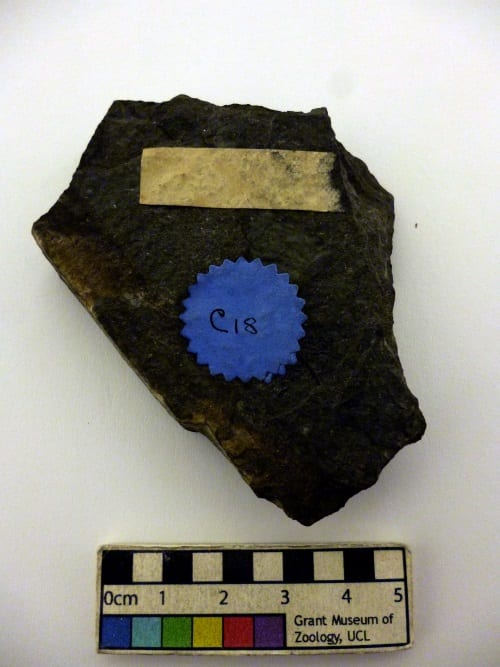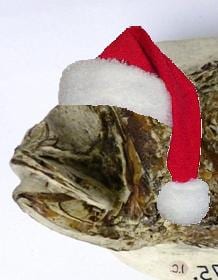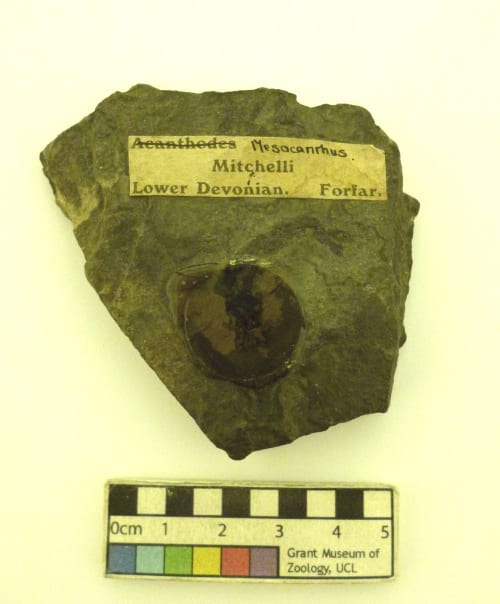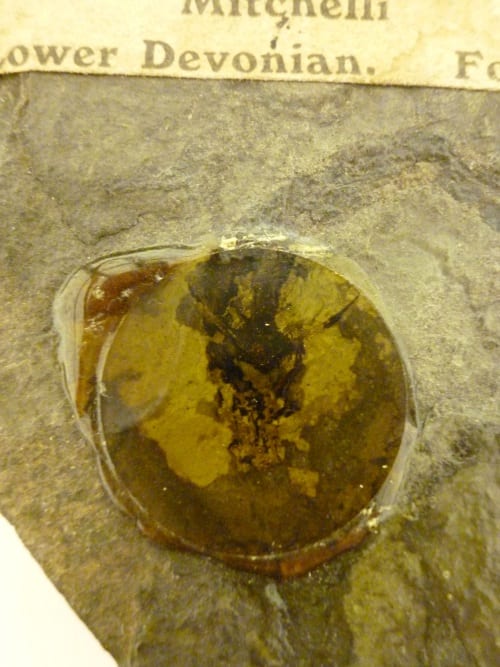Underwhelming Fossil Fish of the Month: December 2014
By Mark Carnall, on 19 December 2014
You’ll never be displayed
For the selection criteria of specimens
Isn’t biased in your way
To save us all from excitement
You’re here to save the day
O drawers of underwhelming fossil fish
Underwhelming fossil fish
O drawers o-hof underwhelming fossil fish.
It’s that time of the year when people of all walks of life come together to celebrate the passing of 12 months of underwhelming fossil fish and look forward to the next 12, hoping the fossils stay quietly unassuming, not too bombastic or boisterous and altogether middling-at-best. This year was particularly unexciting one for fossil fish with many stoically maintaining a state of fossiliferous.
Before we wrap up this year though, like the sitcom episodes made up of recycled footage from older episodes, let us reflect on the year of underwhelming fossil fish that was . We had a fairly boring fish then a very boring one then a cast of dull fish, then a not very exciting one, this one resembled Godzilla a bit, this one was ‘meh’, this one was worse than the first time I wrote it, this one helped pass the time, September’s was Halloween themed, October’s was the underwhelmingest and the less said about last month’s, the better. What a cracking year hey? Now it’s time for our footline act of the year, this one is something particularly unspecial.
NOW WITH YELLOW FILTER FOR THAT ABBA CHRISTMAS FEEL. What a beaut. What you can’t really see in this photo is that the head of this little fish fossil has been covered with a blob of glue so, to me at least, it looks like it’s wearing a Jetson’s space helmet. Here’s a slightly less unhelpful image.
What possible purpose could this dob of glue/resin have here? It’s possible that it was covered to protect particularly exciting but fragile parts of the fossil. It may have been covered so it could be better viewed under microscopy. Lastly, it could be that someone accidentally spilled some glue on this fossil whilst they were doing something else. But that’s not all I’ve got for you, here’s an image of the back of the fossil!

TOO HOT FOR TV! The shot they didn’t want you to see! The reverse of LDUCZ-V1531 Mesacanthus mitchelli with the mysterious blank label. What could it mean?
Check that out! What’s not to love? Is there anything quite so tragic as a label with no information on it? Doubly tragic considering the juxtaposition with the rather racy blue label.
According to the label with information on it, this is a fossil of Mesacanthus mitchelli, with the previous identification of Acanthodes brutally crossed out as a permanent reminder why we ‘permanently but reversibly’ label our specimens today so viewers of the future can’t see our mistakes. This is an extinct species of acanthodian fish that is only known from the Devonian of Scotland, roughly 400 million years ago. Acanthodians are sometimes referred to as spiny sharks on account of the fins being supported by bony spines and because they resemble but aren’t actually sharks.
Preservation This specimen is rather nicely preserved, in particular the bony spines supporting the fins just under the head which is possibly why this section has been further preserved under the blob of resin. There are some lovely Mesacanthus fossils out there, that show the bony fin spines and the scales on the body. I think this specimen has been preserved upside down so the section in resin is the underside of the head of the fish. This species has four rows of spines along the stomach and one dorsal spine on the back. In this specimen it’s only the paired fins and possibly the dorsal fin spine that can be discerned. The shape of the tail, which isn’t supported by bony spines, can be seen here with most of the scales intact.
Research A quick search of the literature throws up surprisingly few references to this species but just enough to initially concern this curator. Many of the fossil fish specimens featured in this series are from the collection of palaeontologist D.M.S Watson, who was former curator of the museum and Jodrell Professor of Zoology and Comparative Anatomy here at UCL. He quite literally wrote the book (well paper) on acanthodian fishes, imaginatively called The Acanthodian Fishes (Watson 1937) and scanning through the references to Mesacanthus mitchelli he makes reference to one specimen in particular looking at the gill slits and jaw apparatus:
One specimen of Mesacanthus (Powrie 1891, 92, 275) gives very important confirmation of this view. It is a young individual very perfectly preserved, the palato-quadrate and Meckel’s cartilages are unossified, but the splint along the lower border of the latter and the entire series of opercular rays are present in their natural positions undisplaced.
The description could match the specimen we have here and as a few UFFoTMers have mentioned in the past, Watson had a habit of sometimes forgetting to send specimens back to people. Fortunately, however, Watson illustrates this volume with plates and this specimen isn’t the one figured so I don’t have to write an awkward letter to National Museums Scotland about returning a long overdue specimen of theirs…. Watson does figure one of his own specimens in this paper but alas it also isn’t this one here. Which probably means we can draw a line underneath research on this specimen and this species. The one person who took more than a passing interest in this species didn’t mention one of his own specimens whilst he was writing the paper on this group of animals. There is one other paper I found, one from 1990, which mention this species but this is in reference to the Watson 1937 paper I just covered. That would have been that, except following the usual speculative googling I managed to find a 2012 Nature paper, Acanthodes and shark-like conditions in the last common ancestor of modern gnathostomes (Davis, Finarelli & Coates 2012), which mentions this very specimen and a number of other Grant Museum fossil fish (albeit only in the supplemental information section). A paper which, previously we had no record of at all! How’s that for a happy end to the year? An otherwise not promising specimens turns out to be one that’s actually been figured, and an underwhelming fossil fish of the month first too! A real Cinderella story which also has nothing to do with Christmas at all.
In Society Sadly, Mesacanthus mitchelli has had little appeal or impact on wider society. However. I’d like to use this space to remind everyone that during this time of year, thousands of underwhelming fossil fish are being bought as presents for budding palaeontologists and fossil fish fans everywhere. Although this is certainly a practice I wouldn’t want to discourage, as long as the fossil fish has been ethically and legally sourced, fossil fish can be difficult to look after requiring regular dusting as well as the demands of enthralling dinner party guests in conversation about your lovely specimen if it is displayed in your living room or on the mantle piece. It may also be the case that your local palaeontologist isn’t familiar with the needs of your fossil fish specimens so, although they make for great companion fossils, do think carefully about giving a fossil fish as a gift this time of year.
Mesacanthus mitchelli
Preservation 5.6
Research 9
In Society 0
Underwhelmingness 6
References
One Response to “Underwhelming Fossil Fish of the Month: December 2014”
- 1
 Close
Close





Interesting! Could it have been collected by CW Peach, who collected lots of fossil fish in Scotland after 1849 and always affixed a paper label to his specimens? Looks like this one has been torn off.